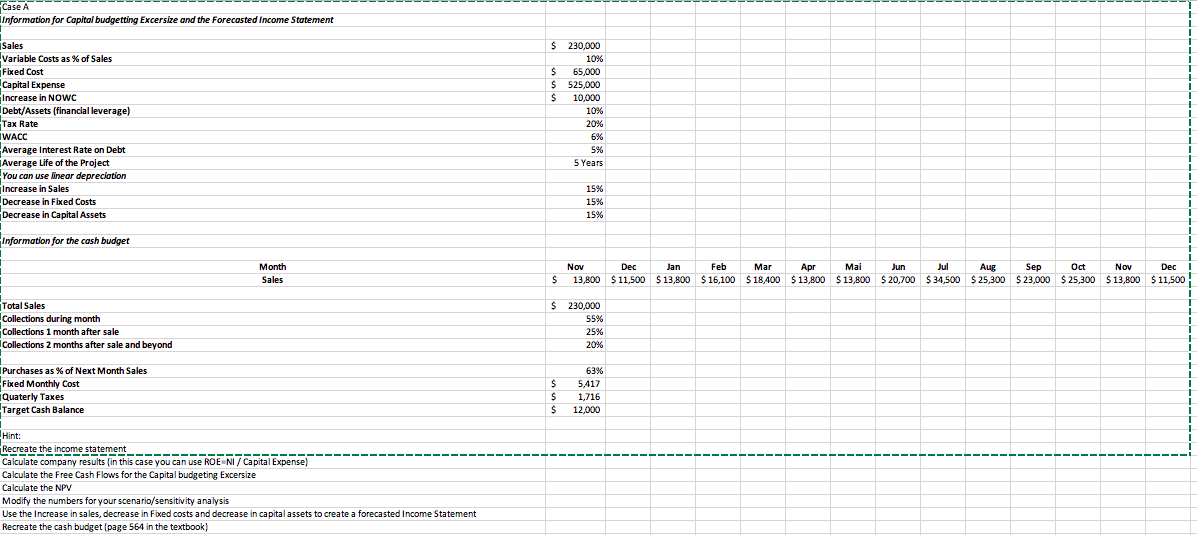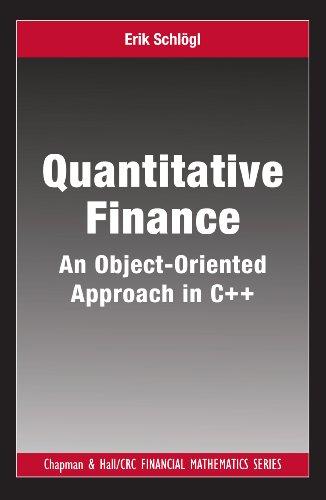Using the information in Case A, please answer the following questions:
Capital Budgeting
1) Create a sensitivity analysis, a scenario analysis, or a Monte Carlo Simulation for the capital budgeting project. Plot the results. What do you notice?
2) Is wealth being generated by the company with this project over a period of 5 years (Hint: calculate the NPV using equal cash flows for years 1 - 4 (same sales and costs for 4 years) and adjusting the final cash flow with the change in NOWC)?
3)How would you improve the outcome, looking at either scenario analysis or sensitivity analysis (Hint: changing the most sensitive driver only a little bit will still have a big impact).
4) How does changing the weighted average cost of capital influence results? Does the company have any control over its WACC?

Case A Information for Capital budgetting Excersize and the Forecasted Income Statement Sales Variable costs as % of Sales Fixed Cost Capital Expense Increase in NOWC Debt/Assets (financial leverage) Tax Rate WACC Average Interest Rate on Debt Average Life of the Project You can use linear depreciation Increase in Sales Decrease in Fixed Costs Decrease in Capital Assets $ 230,000 10% S 65,000 $ 525,000 S 10,000 10% 20% 6% 5% 5 Years 15% 15% 15% Information for the cash budget Month Sales $ Dec Jan Feb Mar Apr Mai Jun Jul Aug Sep Oct Dec 13,800 $ 11,500 $ 13,800 $ 16,100 $ 18,400 $ 13,800 $ 13,800 $ 20,700 $ 34,500 $ 25,300 $ 23,000 $25,300 $ 13,800 $ 11,500 Total Sales Collections during month Collections 1 month after sale Collections 2 months after sale and beyond $ 230,000 55% 25% 20% 1 Purchases as % of Next Month Sales Fixed Monthly Cost Quaterly Taxes Target Cash Balance S S S 63% 5,417 1,716 12,000 Hint: Recreate the income statement------------------ Calculate company results in this case you can use ROE NI / Capital Expense) Calculate the Free Cash Flows for the Capital budgeting Excersize Calculate the NPV Modify the numbers for your scenario/sensitivity analysis Use the increase in sales, decrease in Fixed costs and decrease in capital assets to create a forecasted Income Statement Recreate the cash budget (page 564 in the textbook) Case A Information for Capital budgetting Excersize and the Forecasted Income Statement Sales Variable costs as % of Sales Fixed Cost Capital Expense Increase in NOWC Debt/Assets (financial leverage) Tax Rate WACC Average Interest Rate on Debt Average Life of the Project You can use linear depreciation Increase in Sales Decrease in Fixed Costs Decrease in Capital Assets $ 230,000 10% S 65,000 $ 525,000 S 10,000 10% 20% 6% 5% 5 Years 15% 15% 15% Information for the cash budget Month Sales $ Dec Jan Feb Mar Apr Mai Jun Jul Aug Sep Oct Dec 13,800 $ 11,500 $ 13,800 $ 16,100 $ 18,400 $ 13,800 $ 13,800 $ 20,700 $ 34,500 $ 25,300 $ 23,000 $25,300 $ 13,800 $ 11,500 Total Sales Collections during month Collections 1 month after sale Collections 2 months after sale and beyond $ 230,000 55% 25% 20% 1 Purchases as % of Next Month Sales Fixed Monthly Cost Quaterly Taxes Target Cash Balance S S S 63% 5,417 1,716 12,000 Hint: Recreate the income statement------------------ Calculate company results in this case you can use ROE NI / Capital Expense) Calculate the Free Cash Flows for the Capital budgeting Excersize Calculate the NPV Modify the numbers for your scenario/sensitivity analysis Use the increase in sales, decrease in Fixed costs and decrease in capital assets to create a forecasted Income Statement Recreate the cash budget (page 564 in the textbook)







